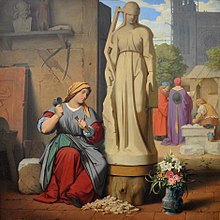Sabina von Steinbach
Sabina von Steinbach was (according to legend) a stonemason of the Gothic style . Allegedly she was born in the 13th century as the daughter of the master builder Erwin von Steinbach at Strasbourg Cathedral . When, after the death of her father, her brother Johann continued building the tower from 1318 to 1339, Sabina is said to have also been involved and made sculptures on the portal.
Officially recognized artistic and creative activity of a woman, in the closed circle of a building works , was almost impossible in the Middle Ages . The traditional assumption that Sabina could still work in this sense goes back to a description of Strasbourg first published by Schadaeus in 1617 , which refers to her name. The pair of figures from Ecclesia and the synagogue at the south portal was attributed to Sabina . The synagogue was popularly known as its self-portrait. In fact, the figures of the Ekklesia and synagogue were created around 1225 (see Ekklesiameister ), half a century before Erwin von Steinbach's appearance and well before the presumed lifetime of Sabina.
Discovery and Afterlife

Despite hardly verifiable data on her life, Sabina was "rediscovered" in German romanticism . Although it cannot be ruled out that her name and reputation were passed on in the local vernacular, this probably goes back to a - now lost - Latin inscription, which was found on the figure of a saint at the cathedral: "The grace of God be with Sabina (SAVINAE), carved out of hard stone by their hand, I stand here as a figure ”. A certain Romantic fascination for this female figure can be seen in Moritz von Schwind's oil painting from 1844 , which depicts Sabina working on the figure of the synagogue . In 1864, two monuments conceived as counterparts, one for Erwin and one for Sabina, were created as works by the artist Philipp Graß , which were placed on the south transept of the Strasbourg cathedral. Sabina appears with a hammer and iron as stone cutting tools. Another poem by Ernst Stadler , published in 1914, has the "old inscription" supposedly pointing to Sabina as a title and indicates that the artist "lifted the two images of women out of the stone".
Even today, the life and work of Sabina can be interpreted - even if mostly viewed as a legend - as a sign of the creative power of a woman in a world that persists in tradition. In a completely different view, the legends surrounding Sabina are seen as a product of a sentimental national consciousness that developed at the end of the 19th century .
Remarks
- ↑ so z. B. 'Stras (s) burg', In: Pierer's Universal-Lexikon . Volume 16. Altenburg 1863, pp. 903-905
- ↑ O (seas) Schadaeus: Summum Argentoratensivm Templum: That is: detailed vn [d] proper description of the much artificial, very precious, and world-famous cathedral in Strasbourg . Strasbourg 1617
- ↑ s. a. J. Schauberg: Comparative manual of the symbolism of Freemasonry with special consideration of the mythologies and mysteries of antiquity - general internal and external history of the Bauhütte. Volume 3, Zurich 1863, pp. 401-405
- ^ A b Leslie Ross: Artists of the Middle Ages . Westport 2003, p. 152 (English)
- ^ Alfred Woltmann: History of German art in Alsace . Leipzig 1876, p. 153
- ↑ Ross: p. 72
- ↑ GRATIA DIVINAE PIETATIS ADESTO SAVINAE (,) DE PETRA DURA PER QUAM SUM FACTA FIGURA
- ↑ Ludwig Spach: Graß, Philipp . In: Allgemeine Deutsche Biographie (ADB). Volume 9, Duncker & Humblot, Leipzig 1879, p. 591 f.
- ↑ Gratia divinae pietatis. In: Ernst Stadler: The departure . Leipzig 1914
- ↑ The no. 1 - sovereign chapter 'Sabina von Steinbach', in the valley of the Rhine and Main of the association 'Liberal Freemasons Scottish Teaching' honors Sabina in the name
| personal data | |
|---|---|
| SURNAME | Sabina von Steinbach |
| BRIEF DESCRIPTION | legendary stonemason |
| DATE OF BIRTH | 13th century or 14th century |
| DATE OF DEATH | 14th Century |